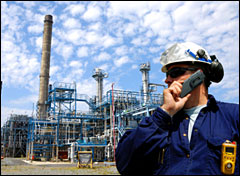Dear Umbra,
I don’t understand carbon credits and how people can buy/sell/trade them. How is this good for our environment?
Elizabeth
Columbus, Ohio
Dearest Elizabeth,
I believe you speak of the carbon credit, rather than the carbon offset? The carbon offset is a consumer product that you or I could buy, enabling us to mildly compensate for our greenhouse-gas emissions by supporting renewable-energy projects. You know, “I’m sorry I’m repeatedly choosing to break your leg, let me apologize by funding medical training in Zimbabwe.” The carbon credit, on the other hand, is an aspect of the industrial “cap-and-trade” program and works slightly differently than the offset. I’ll tackle carbon credits today; if you find yourself thinking, “Dang that Umbra, I really wanted to know about personal carbon offsets,” write again or visit my old column on that topic.

What? You want Yankees box seats
for two more credits?
The “cap-and-trade” system is one of two large-scale greenhouse-gas reduction schemes on the global table, and the more popular. The other is a carbon tax, which we can also discuss someday. One of the first cap-and-trade systems was established in the early 1990s in the U.S. to combat acid rain. It regulates sulfur dioxide emissions from power plants. In 2005, the European Union instituted a cap-and-trade system (“Emissions Trading System”) to regulate greenhouse gases; it covers electric power plants and major energy-intensive industries.
Very broadly, the concept behind cap-and-trade is this: The government decides upon a “cap,” a maximum amount of emissions allowed across an industry or sector. The cap should be lower than the status quo. Said government then issues permits to pollute, either by giving them away or by auctioning them off. Then the “trade” aspect begins. The permits each allow a certain amount of pollution. If a business can reduce its emissions and end up with extra permits, it can sell those permits for a profit to businesses that want to/must pollute more than they are allowed.
The polluters, for their part, can choose to pay for permits or find technical innovations that will bring down their emissions. Ideally, the market price of permits — a desirable but limited resource — rises and becomes increasingly prohibitive. In this dreamy scenario, buying a permit becomes more expensive than conservation, and businesses spend the money on retrofitting their systems instead.
Cap-and-trade has worked very well with acid rain. Power plants in the U.S. reduced their sulfur dioxide emissions more than was required, and the cost was lower than anticipated. There is also a successful multi-state collaboration that uses cap-and-trade to reduce ground-level ozone in nine states and Washington, D.C. The E.U.’s ETS started off with a few stumbles, but is working out the kinks. Now two sets of U.S. states and neighbors are in negotiation to start cap-and-trade systems for carbon dioxide: The Regional Greenhouse Gas Initiative involves 10 states in the East; the Western Climate Initiative currently involves seven Western states and three Canadian provinces. A federal attempt at cap-and-trade, which Bush would have vetoed, just died in Congress.
That is a very brief summary of cap-and-trade. Theoretically, it helps the environment through setting an absolute limit on a pollutant, within an economic system that encourages innovation. Industry, transport, and the commercial sector produce the bulk of our country’s emissions, around 75 percent. We individuals have a valid and vital role to play at home and work, and through our personal transport, but industry needs to start reining in carbon production. Cap-and-trade systems are one way to get a group of businesses involved in bringing down our global emissions. May they continue to be one way among many, and may they be successful.
Fervently,
Umbra

